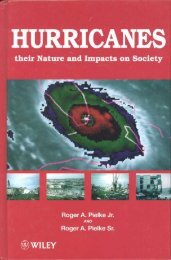Equivalent temperature - Climate Science: Roger Pielke Sr.
Equivalent temperature - Climate Science: Roger Pielke Sr.
Equivalent temperature - Climate Science: Roger Pielke Sr.
Create successful ePaper yourself
Turn your PDF publications into a flip-book with our unique Google optimized e-Paper software.
3. Trend differences between T and T E<br />
3.1. Annual and seasonal patterns<br />
When a straight average (all stations weighted equally;<br />
mentioned in Section 2) is computed for the trend estimates<br />
of all stations over all seasons, the difference between<br />
the TE and T trends is positive and significant at over<br />
99% (Table 3). When one only averages over those trends<br />
which are significantly different from zero at the 90%<br />
level or higher, there continues to be positive ΔT E−ΔT<br />
trend differences as for when all stations are considered.<br />
C.A. Davey et al. / Global and Planetary Change 54 (2006) 19–32<br />
Seasonally, in general, the annual cycle indicates a<br />
transition from T E trends showing significantly more<br />
warming/less cooling than T in the winter and early<br />
spring, to significantly more cooling/less warming in the<br />
fall months (Fig. 2, Table 4). The preceding results were<br />
for the case where all trends are considered. These same<br />
patterns are present when the analysis is narrowed to look<br />
only at those individual trends that are significantly different<br />
from zero at a specified significance level. As the<br />
trend significance increases, however, the difference between<br />
the averaged T and T E trends becomes less significant<br />
during the winter and spring months (Table 4).<br />
Fig. 6. Seasonally-averaged differences between TE trends and T trends for 1982–1997, as a function of the land cover classes listed in Table 2, for (a)<br />
winter — JFM, (b) spring — AMJ, (c) summer — JAS, and (d) fall — OND. Error bars indicate standard errors. For each of these computations, all<br />
stations are weighted equally.<br />
25














